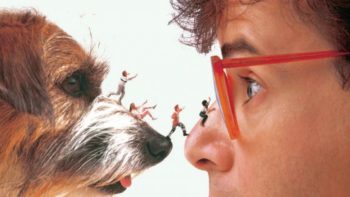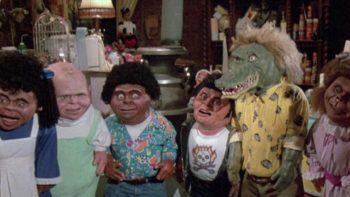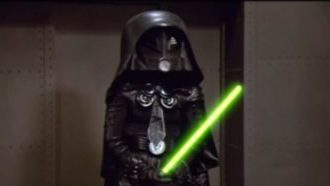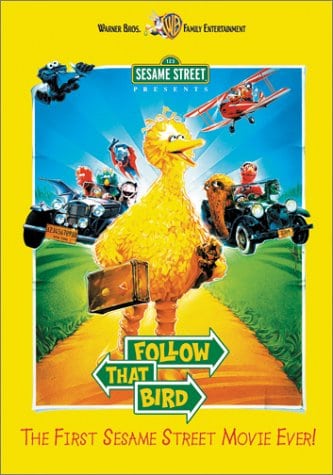
Seasame Street is obviously a beloved show and cultural institution. The Muppets have made a great transition to the big screen, but could the same work for the characters of Sesame Street?
Follow That Bird was a live-action movie released by in 1985 musical/road-comedy film produced by the Warner Bros and The Jim Henson Company. It tells the story of Big Bird having to leave Sesame Street and eventually making his way home. It was a box office failure but still managed to find an audience on home video.
The year was 1985 and if you were a fan of movies, this was a pinnacle part of the decade (Check out my article on why 1985 is the best year of the decade). So many incredible movies came out this year including:
- Back to the Future (check my article on things you missed in BTTF)
- The Goonies
- The Breakfast Club
- Pee-Wee’s Big Adventure
- Gremlins
- Ghostbusters
- Mad Max
This is just scratching the surface, but the point is: it took a lot to stand out amongst that year’s competition. This had a major impact on Follow That Bird as a movie starring well-known, and beloved, characters just wasnt able to make a dent in the box office.
It may have been that the tone of the movie was a little too intense for kids, or that the whole Sesame Street world just doesn’t translate over to the big screen. In either case, Follow That Bird is an interesting story of a kids movie that probably should have been more successful than it was.
The Plot of Sesame Street Presents: Follow That Bird
As mentioned, this movie is a standard Jim Henson go-to road trip movie. It worked really well for the Muppet Movie but didn’t have the same success with the Sesame Street characters. The movie is based around a 6-foot canary named Big Bird who lives on a street called Sesame Street (am I really having to explain that part?)
Fun Fact: Big Bird is the very first puppet to appear on Sesame Street when it first started. Also, did you know that Big Bird/Carrol Spinney was going to be on the Challenger space shuttle originally? They were trying to create more interest in the space program and thought Big Bird would be a way to do this. When it came time to train for it all they couldn’t fit the 8-foot costume on board and civilian/school teacher Christa McAuliffe was chosen to go in his place. Pretty crazy.
The Feathered Friend’s Board of Birds has tracked down Big Bird and wants to place him with his own kind. Miss Finch from the board travels to New York to visit Sesame Street and bring him to the Dodo family that lives in Illinois.
The Dodo’s, and their kids (who seem based on Donny and Marie Osmond) don’t see eye-to-eye with Big Bird and he eventually has enough of their crap and get’s the hell out of Dodge. Big Bird is now on the lam and this story has hit the national news. Everyone on Sesame Street sees this story and springs into action to help their giant friend.
On his journeys, Big Bird will end up meeting John Candy and some other SCTV alumni, hitches a ride with Waylon Jennings and stays with two kids on their farm. While Big Bird is on the run he’s not only being tracked by Miss Finch but the Sleaze Brothers. With names like that you know they can’t be up to any good.
The Sleaze Brothers have plans to kidnap Big BIrd, are able to do so, and force him into dressing in blue face and perform in a carnival. The Sesame Street gang has found Bird at the carnival but the Sleaze Brothers make a break for it. Big Bird is eventually rescued, brought back to Seasame Street, and realized this is his one true home.
Follow That Bird Cast & Characters
Some of these are going to be very obvious but it’s worth looking at the amazing performers during the prime of the Jim Henson Company. This movie was also considered the last time that Jim Henson would perform Kermit in a movie.
- Jim Henson – performed Kermit and Ernie
- Carroll Spinney – Big Bird, Oscar the Grouch, Bruno the trashman
- Frank Oz – Bert, Grover, and I had never known this: Cookie Monster
- Jerry Nelson – Count Von Count, Herry Monster
- Martin P. Robinson – Snuffleupagus (did you know that’s how that’s spelled? I had no idea), Telly Monster, Poco Loco, board member,
- Bryant Young played the back of Suffleupagus – that’s a tough gig
- Cheryl Wagner performed Miss Finch
- Trish Leeper performed Momma Dodo
- Gord Robertson as Daddy Dodo
- Shari Weiser as Marie Dodo
- Jeff Weiser as Donnie Dodo
- Tim Gosley as Homer Honker and a board of birds member
- Noel MacNeal as Madame Chairbird
- Pam Aciero as Grundgetta
Those were the physical performers but additional voices would include Brian Hohlfeld as Daddy Dodo, Laraine Newman as Mommy Dodo, Cathy Silvers as Marie Dodo, and Eddie Deezen as Donnie Dodo.
For the human performances you had the regular cast of Sesame Street with a few others added in, including:
- Bob McGrath
- Roscoe Orman as Gordon
- Linda Bove
- Emilio Delgado as Luis
- Sonia Manzano as Maria
- Alaina Reed as Olivia
- Lorretta Long as Susan
- Kermit Love as Willy (apparently there is no connection between the naming of Kermit and Kermit Love who is one of the old school Muppeteers)
- Joe Flaherty as Sid sleaze
- Dave Thomas as Sam Sleaze
- Alyson Court as Ruthie
- Benjamin Barrett as Floyd
Production On Follow That Bird
The first thing regarding the production is that I had no idea this movie was basically filmed in my backyard. Well, not my ACTUAL backyard, but here in Ontario only an hour or so from where I live. The movie started filming in 1984 and hey would also use Toronto International Film Studios and completely recreate the Sesame Street set.
They created a much bigger and roomier set. This would not only allow for more muppets and actors but give a larger scope that would hopefully translate well on to the big screen. The new street now included a fire station, music store, autobody shop, bakery, grocery store, and book store.
If you thought this movie had a different look than what you were used to seeing on TV, you’re right. The idea was to give the movie a richer and more film-like quality to separate it from the lower quality TV show. Cinematographer Curtis Clark was brought in to help achieve this different look.
Clark had previously worked on a very “arty” film called “The Draughtsmen’s Contract” and it was hoped he could bring some of that style to Follow That Bird.
Producing the film was a relative newcomer named Ken Kwapis. He had just got out of film school in 1983 but after meeting with Jim Henson was offered the job on the spot. John Landis had been the first choice but had dropped out to film “Into The Night” – so I guess that worked out for him?
Why Follow That Bird Was A Little Too Intense
This is the tough thing they faced when filming the movie. Most of these characters have not been fully developed on Sesame Street. They appear on screen for usually a few minutes at a time and are there to serve a larger purpose such as teaching lessons (math, spelling, colors etc). They have never been fully fleshed out and the movie would not only do that but go pretty deep while doing so.
Just the concept of ripping Big Bird away from Sesame Street was potentially jarring for younger viewers. From there, Big Bird takes on a Joseph Campbell/Hero’s Journey quest that has been used in countless movies most notably with Luke Skywalker in Star Wars. They had the difficult task of exploring these emotional plot points while still trying to keep things fun and whimsical.
The movie is still a musical but there aren’t any notable stand out songs like there has been with the Muppet movies. Whereas the Muppet movies had been about wacky adventures and trying to make it in show business, Big Bird is forced to face emotional decisions and come to grips with himself.
To me, they went a bit too far with the emotional aspect of the film as that’s what I remember taking away from it as a kid. The most notable part of the movie for many kids is when Big Bird is captured, turned blue, and forced to sing at the carnival. Big Bird is essentially a 6-year-old kid and his reactions and viewpoint are easily corrupted and I think kids watching were able to empathize with this.
Follow That Bird, of course, has a happy ending, but it goes through some pretty deep stuff to get there.
Is There A Race Theme In This Movie?
Speaking of deeper themes in the movie, there’s another one that appears pretty glaring. It’s kind of hard to ignore it but themes or race seem to be an underlying message in Follow That Bird. To start, there’s the issue that birds are thought to only be with other birds. To most birds, this seems to be such an issue that they end up forming a board focused on the best interest of keeping birds together.
Miss Finch plays the role of this “evil” manifestation of bird relations. She also is completely delusional and seems to think she is doing the right thing. She represents, to me, small-minded and ignorant people who have trouble looking beyond their own misguided ideals.
Ultimately, the movie focuses on themes of unity and the inclusion of all people – something Seasame Street has been doing since day one. Both the show and the movie celebrate the differences between people and that’s one of the take-home messages in Follow That Bird.
The Response To Follow That Bird
Critically, the movie was received pretty well. Today, it still has a 92% rating on Rotten Tomatoes, but that site seems to have become a bit of a cesspool and not always that trustworthy in their ratings so take that for what it’s worth.
Even with the positive response from critics, and the fact it was a Sesame Street movie – it got pretty crushed at the box office. I’m not sure what the problem was though. It honestly must have to be because of the amount of massive competition that it faced. The only other thing I can think of is parents dreaded the idea of taking – what would be younger – kids and schlepping them all the way to a movie when they could just watch Sesame Street every day on TV.
Follow That Bird opened on August 2, 1985. It opened the same weekend as Weird Science and Fright Night and Pee-Wee’s Big Adventure, Back to the Future, and The Black Cauldron were still going strong. All of these are kind of “family movies’ so I’m not sure if they were taking business away from Follow That Bird. The main thing is this was one of the biggest movie summers of the 80s so it probably wasn’t playing on too many screens.
They also had reissued E.T., Gremlins, and Ghostbusters so that probably didn’t help things either. Either way, Follow That Bird made only $2.4 million its opening weekend and just under $14 million for its entire run. This was seen as a huge disappointment and actually had a financial effect on the Children’s Television Workshop.
The Legacy & Finding A New Audience
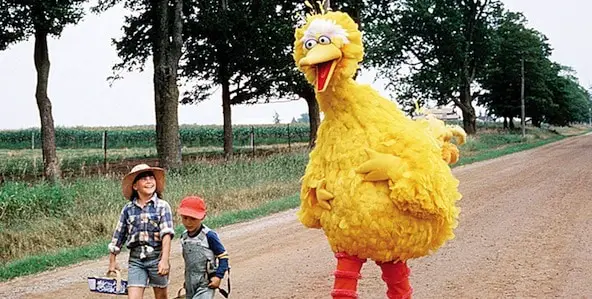
Similar to movies like Flight of the Navigator, Follow That Bird would find a bigger audience on home video. Home video was still relatively new at the time and the concept of owning a movie that you could watch over and over was just starting to become commonplace. (check out my article about the VHS/BETA wars and the advent of the VCR to see more about this!).
The movie was released on VHS and LaserDisc (check out my LaserDisc article too!) in 1986 and every kid who had missed it in the theatre finally got to see it – including me. I first got to watch it at my neighbours house and even though it was slightly overwhelming, it still compelled me.
Kids would now embrace the movie even more with many physically wearing out copies of the tape.
But I think Follow That Bird is an interesting look at something that just didn’t hit right. If it had come out a few years later, or earlier, it might have had a different response. It ultimately would get the right response, but not until it was popped into the VCR in the family living room.
Oh ya, and when Bert and Ernie are flying in the plane, Jim Henson and Frank Oz were actually in a biplane that was upside down to film this.
And that’s pretty badass.

